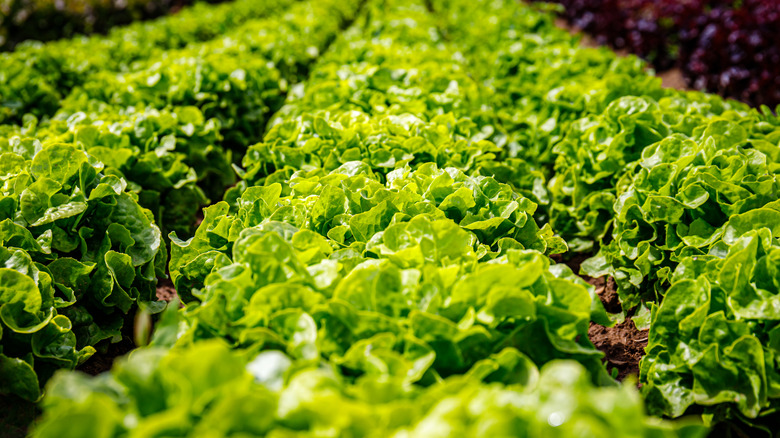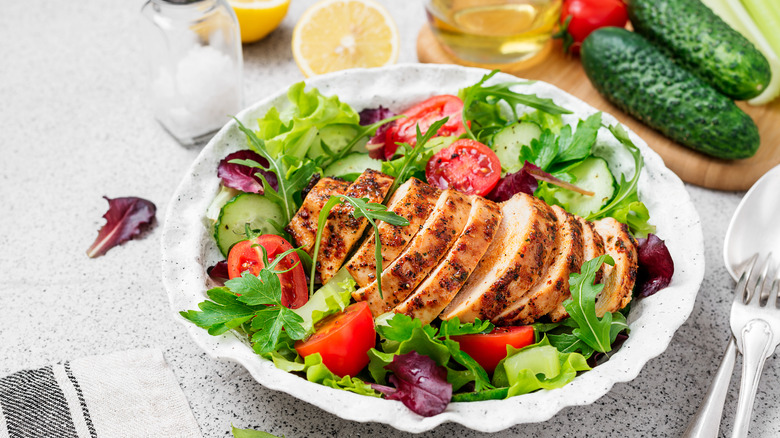The Big Mistake Everyone Makes When Preparing A Salad
If you've been watching Girls5Eva, then you may recall Busy Philipps' character, Summer, being sent into a downward spiral when given the most important task of making the salad. It turns out she doesn't know how to "cook salad" and needs some guidance. Hopefully you aren't as lost on the concept as the fictional Summer. But maybe you still have some questions. What are some common things to add to salad? What are some flavors that blend well together and what are some that need a restraining order?
Some people try to downplay the allure of a salad by not giving much thought to what ingredients are being put together. You want to get those taste buds excited! Salads are meant to be bright and full of life. But too often, they are served as just filler or a means to a weight loss end. No more! It's time to take back the salad and give it the spotlight it deserves. Let your salad be the main attraction. There are steps that can be taken to improve your salad's quality and nutritional value. Add some color, uncommon proteins and keep your greens as crispy as possible.
No one likes soggy greens
When making a salad, it's common to start with the base. Most will head straight for iceberg lettuce. But why limit yourself? Kale, spinach, microgreens, and more are looking for an invite to the party. You'd be surprised at how much flavor these seasonal gems will provide. Once you've chosen your base greens, make sure to wash and dry them. A salad spinner works wonders for decreasing the amount of water retained in your greens.
If you don't have a salad spinner to use, Bon Appétit has a handy trick: "Line a plastic shopping bag with paper towels, throw in your greens, and knot the bag. Then take the bag by the handle and give it a couple good, hard spins in the air." Leftover water isn't the only thing that can contribute to making your salad soggy. Over dressing or not properly dressing your salad can be the quickest way to murder your leafy goodness.
Cook's Illustrated conducted an experiment where three separate batches of mixed greens were tossed with oil and then vinegar; tossed with vinegar and then oil; and tossed with a fully emulsified dressing made with vinegar, oil, and a little bit of mayonnaise and mustard. The winner was the emulsified vinaigrette, as the combination provided the salad greens with the best protection: the key being the vinegar, which coats the greens with a barrier that keeps oil out. As the outlet explains, liquids cannot penetrate a salad leaf's "protective waxy cuticle layer," but oil can, so you need to help the greens form an even stronger coat.
Your salad can be whatever you want
When making a salad it's OK to let your imagination soar. The anatomy of a salad is really up to you and your taste palate. No need to only stick to lettuce, tomatoes, and shredded carrots. Unless that's your thing. After your base greens, choose a few of your favorite veggies to add to the mix. Red bell peppers and corn are just a couple vegetables that get overlooked. They are a great way to add a pop of color.
And speaking of color, if you are feeling particularly bold, try adding some fruit, like clementine or dried cranberries. Nuts like sunflower seeds, or walnuts give a sufficient crunch factor. Protein in the form of grilled chicken breast or eggs can make for a very satisfying topper. Just make sure to be mindful of the amount and type of protein added. Add too much bacon or fried instead of grilled chicken and you run the risk of making your healthy choice, not so healthy.
With the weather getting warmer, now is a great time to expand your salad repertoire by adding new ingredients you may have overlooked in the past. Giving yourself more salad options to choose from, makes it more appealing to try and keep at least one salad on the menu a day.


